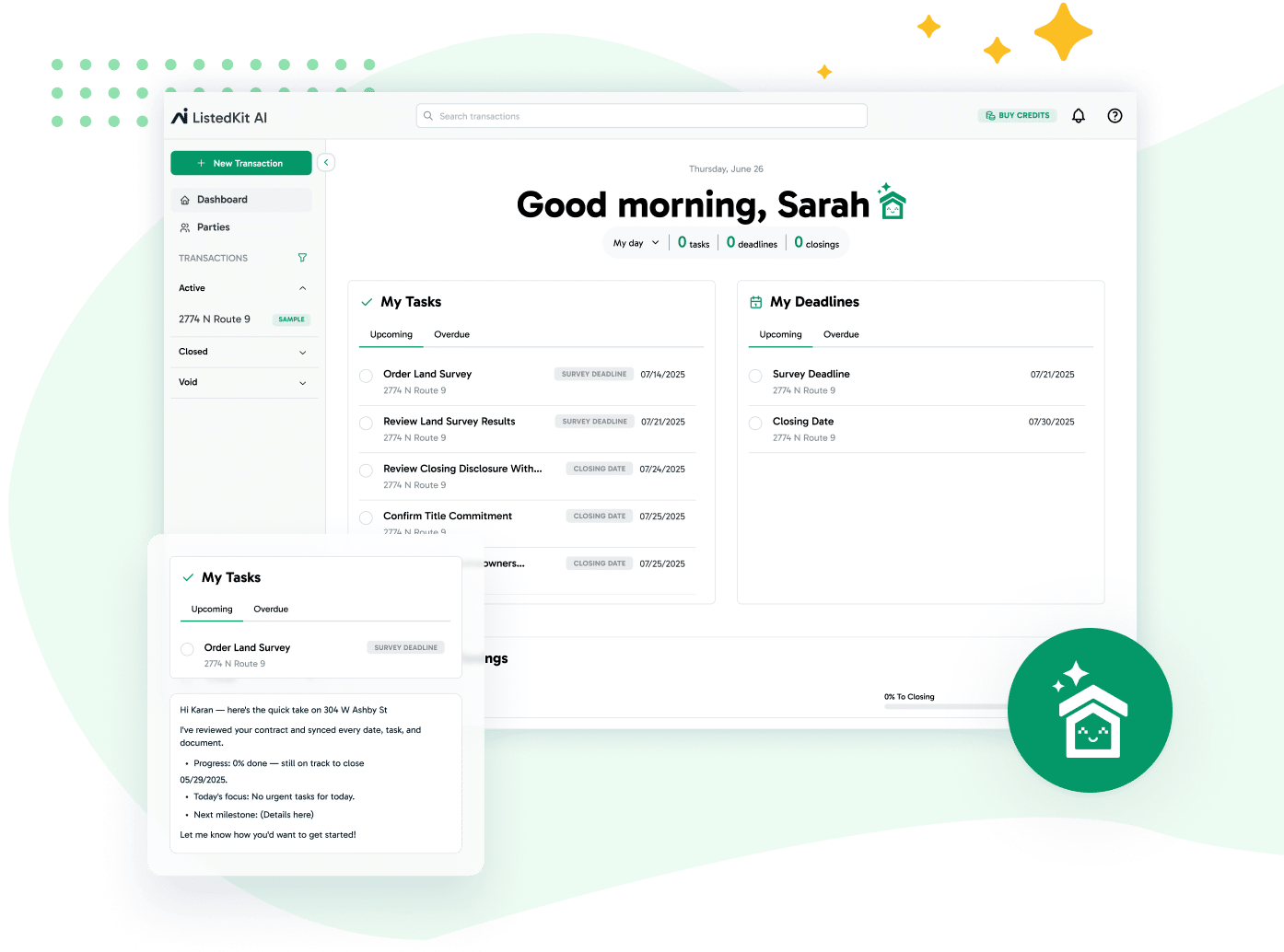Real Estate paperwork management is one of the main concerns when it comes to coordinating transactions which is why creating systems that allow you to manage it effectively is crucial for success. By implementing the right systems and processes, you can avoid the frustration of constantly chasing down documents from other parties. After our conversation with Chelsea Wright, we decided to consolidate some of the strategies you can use to streamline your workflow, improve communication, and create a seamless paperwork management system.
1. Simplify and Streamline Communication
One of the biggest challenges in communication is overcomplicating the message (news alert: we have all fallen victim to this at some point). Relationship building is 90% of a transaction coordinator’s job, making both written and verbal communication extremely valuable. Think about it: agents are busy and receive millions of emails a day. If you need them to do something urgent, there’s no point in dancing around it because chances are you’ll lose them in the fluff, and the email will go unnoticed. Instead, keep it simple and to the point so that they know what you need and when you need it.
From This ❌
“I’m writing to inform you that the inspection period will be ending in 3 days and we need to submit our repair requests by close of business on Friday”
To This ✅
Action needed: Submit repair requests by Friday 5 PM.”
To avoid communication pitfalls:
- Keep messages concise:
- Limit emails to essential information.
- Use bullet points for easy scanning.
- Highlight action items or deadlines.
- Consider your audience:
- Tailor your communication style to agents and clients.
- Use industry terms with agents but plain language with clients.
- Consider the preferred communication method (email, text, phone) for each recipient.
- Use consistent language:
- Develop standardized templates for common situations (e.g., inspection reminders, closing checklists).
- Create a “phrase bank” for frequently used explanations or instructions.
- Establish authority:
- Present your communication system as battle-tested and proven effective.
- Use phrases like “Our standard process is…” or “Based on our experience with thousands of transactions…”
By simplifying your communication and keeping it direct, you ensure that your messages are clear and effective, fostering better relationships and smoother transactions.
2. Implement a Lean Process
Streamlining your transaction coordination (TC) workflow can significantly enhance efficiency and productivity. Here are some principles to guide you:
- Minimize steps: Analyze your current process and eliminate unnecessary actions.
- For example; instead of printing and scanning documents, use digital signatures whenever possible.
- Optimize workflow: Arrange tasks in the most logical and efficient order.
- For example; send out all disclosure packets immediately after contract acceptance, rather than waiting for the title report. Check out this blog on task batching for more insights on how to put this into practice.
- Consider all parties: Design your system to benefit both you and your clients.
- For example; leverage software portals to create a shared timeline that all parties can access, reducing status update requests.
- Anticipate needs: Structure your workflow to prevent delays and reduce the need for follow-ups.
- For example; use email automation to schedule automatic reminders for common deadlines (inspections, loan approval, etc.) at the start of each transaction.
By implementing these lean principles, you can create a more efficient TC process, leading to smoother transactions and satisfied clients.

Set Your Systems Up to Stop Chasing Paperwork
Try ListedKit today and experience seamless transaction management.
3. Centralize Paperwork Management
Using a single platform for paperwork management in real estate can significantly improve efficiency:
a) Choose a versatile tool:
- Leverage brokerage tools like DocuSign or SkySlope that allow for template creation and easy customization.
- Look for features like bulk sending, automated reminders, and integration with other tools you use.
b) Create templates:
- Develop templates for common transaction types (e.g., Oregon listing, Washington listing) and high-volume agents.
- Include all necessary forms in the correct order to reduce errors and omissions.
c) Automate follow-ups:
- Use virtual assistants or automated systems to resend unsigned documents and send reminders.
- Set up a system to escalate phone calls after a certain number of unanswered reminders.
d) Implement regular check-ins:
- Send weekly updates summarizing outstanding items and action needed.
- Use a visual system (like red/yellow/green status indicators) for quick understanding.
4. Shift from Inquiring to Informing
Change the dynamic of your relationships by proactively providing information:
- Anticipate needs: Stay ahead of questions by providing relevant updates before they’re asked.
- Example: Send a “What to Expect” timeline at the start of each transaction phase.
- Be proactive: Inform agents and clients about file status, outstanding tasks, and next steps.
- Example: “The appraisal is scheduled for Tuesday. Here’s what the sellers need to do to prepare…”
- Establish authority: Position yourself as a knowledgeable partner rather than an order-taker.
- Use phrases like “Based on my experience, I recommend…” or “Our data shows that…”
5. Standardize File Organization
Consistent file organization is critical, especially as you scale:
- Use a uniform naming convention: Implement a standardized system for naming files and emails.
- Example: “123MainSt_OfferAcceptance” or “456ElmAve_InspectionReport”
- Avoid personal names: Don’t rely on client or agent names for organization, as this can lead to confusion with common surnames. Instead, use unique identifiers like property addresses or transaction numbers.
- Centralize communication: Use a single email thread for each transaction, bringing all parties back to this chain for updates.
- Example subject line: “TRANSACTION UPDATE: 789 Oak Lane – Week of 7/24”
6. Leverage Automation
While human oversight is still necessary, automation can significantly reduce your workload:
a) Automate data entry:
- Use software that facilitates entering transaction details to populate transaction tracking tools automatically. ListedKit is a great example of this as it uses AI to extract information directly from contracts.
- Set up integrations between your email, calendar, and task management systems.
b) Create triggers:
- Set up automated actions based on specific events or milestones in the transaction.
- Example: Automatically send a closing checklist when the appraisal is received.
c) Delegate routine tasks:
- Use virtual assistants for manual data entry and initial contract review.
- Create detailed process documents to ensure consistency across team members.
d) Maintain quality control:
- Always perform a final review of automated processes to ensure accuracy.
- Regularly audit your automated systems to catch and correct any errors.
7. Set Clear Expectations
Establishing clear guidelines and boundaries is essential for smooth operations:
a) Define your process:
- Clearly communicate your workflow and expectations to agents and clients.
- Create a “Welcome Packet” that outlines your services, communication style, and timelines.
b) Establish response times:
- Set realistic timeframes for addressing urgent matters and routine tasks.
- Example: “We respond to urgent matters within 1 hour during business hours and routine inquiries within 24 hours.”
c) Differentiate urgency levels:
- Educate agents on the difference between true emergencies and urgent situations.
- Provide examples: “A burst pipe in the property is an emergency. A last-minute repair negotiation is urgent, but not an emergency.”
d) Manage workload:
- Be transparent about your capacity and set realistic deadlines for task completion.
- Use phrases like “Given our current workload, we can have this completed by…” rather than overcommitting.
By implementing these expanded strategies and examples, transaction coordinators can significantly reduce the time and effort spent chasing down real estate paperwork. Remember, the key to success lies in simplicity, consistency, and proactive communication. As you refine your processes, you’ll find yourself spending less time on administrative tasks and more time adding value to your clients and growing your business.




